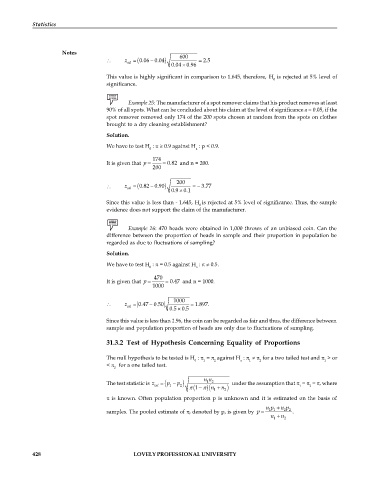Page 436 - DMTH404_STATISTICS
P. 436
Statistics
Notes
600
z cal = (0.06 0.04- ) = 2.5
0.04 0.96
´
This value is highly significant in comparison to 1.645, therefore, H is rejected at 5% level of
0
significance.
Example 25: The manufacturer of a spot remover claims that his product removes at least
90% of all spots. What can be concluded about his claim at the level of significance a = 0.05, if the
spot remover removed only 174 of the 200 spots chosen at random from the spots on clothes
brought to a dry cleaning establishment?
Solution.
We have to test H : ³ 0.9 against H : p < 0.9.
0 a
174
It is given that p = = 0.82 and n = 200.
200
200
z cal = (0.82 0.90- ) = - 3.77
0.9 0.1
´
Since this value is less than - 1.645, H is rejected at 5% level of significance. Thus, the sample
0
evidence does not support the claim of the manufacturer.
Example 26: 470 heads were obtained in 1,000 throws of an unbiased coin. Can the
difference between the proportion of heads in sample and their proportion in population be
regarded as due to fluctuations of sampling?
Solution.
We have to test H : = 0.5 against H : 0.5.
0 a
470
It is given that p = = 0.47 and n = 1000.
1000
1000
-
z cal = 0.47 0.50 = 1.897.
0.5 0.5
´
Since this value is less than 1.96, the coin can be regarded as fair and thus, the difference between
sample and population proportion of heads are only due to fluctuations of sampling.
31.3.2 Test of Hypothesis Concerning Equality of Proportions
The null hypothesis to be tested is H : = against H : for a two tailed test and > or
0 1 2 a 1 2 1
< for a one tailed test.
2
n n
The test statistic is z = p - p ) 1 2 under the assumption that = = , where
cal ( 1 2 1 2
n +
(1 - )( 1 n 2 )
is known. Often population proportion p is unknown and it is estimated on the basis of
n p + n p
samples. The pooled estimate of , denoted by p, is given by p = 1 1 2 2 .
n + n
1 2
428 LOVELY PROFESSIONAL UNIVERSITY

